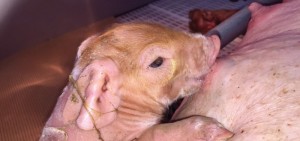 A new campaign is highlighting how the ‘liquid gold’ properties of colostrum can play a key role in reducing the need for antibiotics in farm animals and improving their lifetime performance.
A new campaign is highlighting how the ‘liquid gold’ properties of colostrum can play a key role in reducing the need for antibiotics in farm animals and improving their lifetime performance.
 The #ColostrumIsGold campaign, running throughout the spring, will highlight how the ‘liquid gold’ properties colostrum can play a key role in reducing the need for antibiotics in farm animals and improving their lifetime performance.
The #ColostrumIsGold campaign, running throughout the spring, will highlight how the ‘liquid gold’ properties colostrum can play a key role in reducing the need for antibiotics in farm animals and improving their lifetime performance.
It will aim to promote best practice, mainly based around achieving the three Qs – ‘quality, quantity and quickness’ – of colostrum delivery, using social media to help deliver the messages.
You can view the campaign website here
Farmers and vets looking for more information should search for the #ColostrumIsGold hashtag on Twitter, or visit www.FarmAntibiotics.org for useful tools, resources and case studies during February.
Driven by the Responsible Use of Medicines in Agriculture (RUMA) alliance, the campaign will underline that responsible use of antibiotics starts with animals receiving the right amount of colostrum within a couple of hours of birth – something all farmers have the potential to achieve.
Pig specialist Mandy Nevel, veterinary lead at AHDB, said piglets need colostrum to maintain body temperature and protect them against disease. “Baby pigs are born wet and with very little energy reserve. Ideally they need to get a feed in within the first 30 minutes to prevent hypothermia. This early feed will also provide essential immunity, giving them the best chance of survival in their first few weeks of life.”
She highlighted post-weaning diarrhoea and respiratory disease as longer-term threats for piglets that receive insufficient colostrum at birth and said sow vaccination was the best way to boost antibody levels in the colostrum.
“Piglets that receive good levels of colostrum early will also be the healthiest at weaning. That extra care in the first hours of life will really make a difference. Colostrum really is a golden opportunity to secure lower antibiotic use and a healthier animal for its whole life,” Dr Nevel said.
The NPA welcomed the campaign, which will highlight practical ways to improve the health status of animals. “There is no silver bullet for reducing antibiotic use on pig farms,” senior policy advisor Georgina Crayford said. “What’s important is the cumulative effect of numerous good management practices and disease prevention strategies, and ensuring piglets get good colostrum intake is a great example.”
See the Pig World Veterinary View comment on the subject here
Colostrum for pigs – key facts
AHDB has published a fact sheet on colostrum, which can be viewed here. Key points include:
- Colostrum is secreted from the udder immediately after farrowing
- It contains essential antibodies (immunoglobulins) to boost newborn piglets’ defence against bacteria and viruses
- It is also a rich source of highly digestible nutrients, which are critical to establishing the newly born piglet
- Intake depends on the piglet’s ability to extract colostrum and the sow’s ability to produce enough for the litter
- Sow parity and nutrition, litter size and piglet size and vigour at birth can all influence colostrum production and consumption
- Colostrum intake must be optimised as soon as possible after farrowing. After six hours, the gut begins to ‘close’ and after 24 hours, the full benefits of immunoglobulins are no longer available to the piglet
- Unless sufficient colostrum has been consumed, the piglet remains highly vulnerable to disease
- Colostrum intake by the newborn piglet is highly variable. A general guide is that piglets will consume 150–280g/kg bodyweight soon after birth, or 200-400kg/piglet.
How can colostrum production be optimised?
- Good sow management principles to ensure high colostrum and milk yields and litter productivity include:
- Reduce stress before, during and after farrowing
- Feed diets appropriate for pregnancy and lactation
- Ensure sows have unrestricted access to fresh drinking water at all times.
How can each piglet get a fair share?
- Supervision during and immediately after farrowing should focus on early establishment of piglets at the teats
- Batch farrowing can assist in implementing stockworker supervision
- Cross-fostering can help. It should take place ideally within 24 hours or sooner after farrowing. If this is not possible, colostrum sharing in large litters should be facilitated by shift (split) suckling
- If porcine colostrum is unavailable, bovine colostrum may be used
- Consider milking off and freezing surplus colostrum from some sows (although this is not a practical option on most commercial farms).




